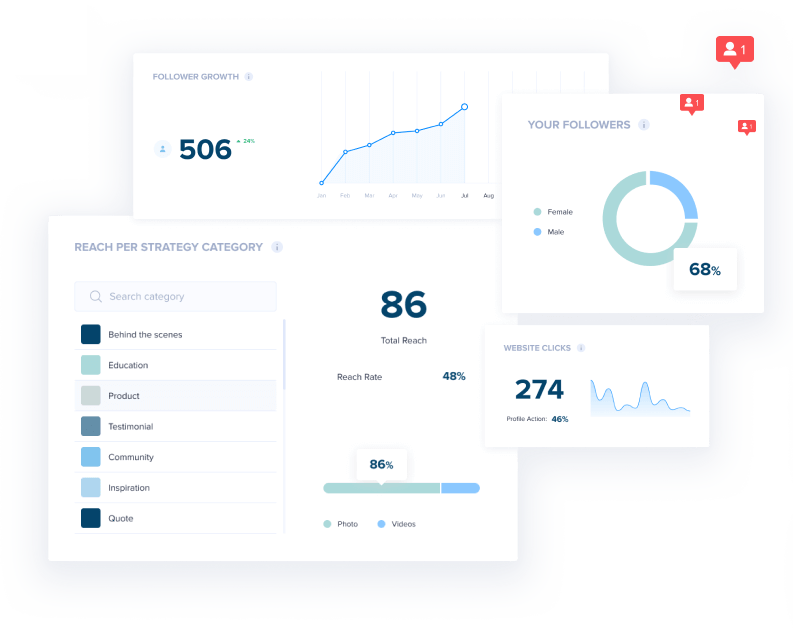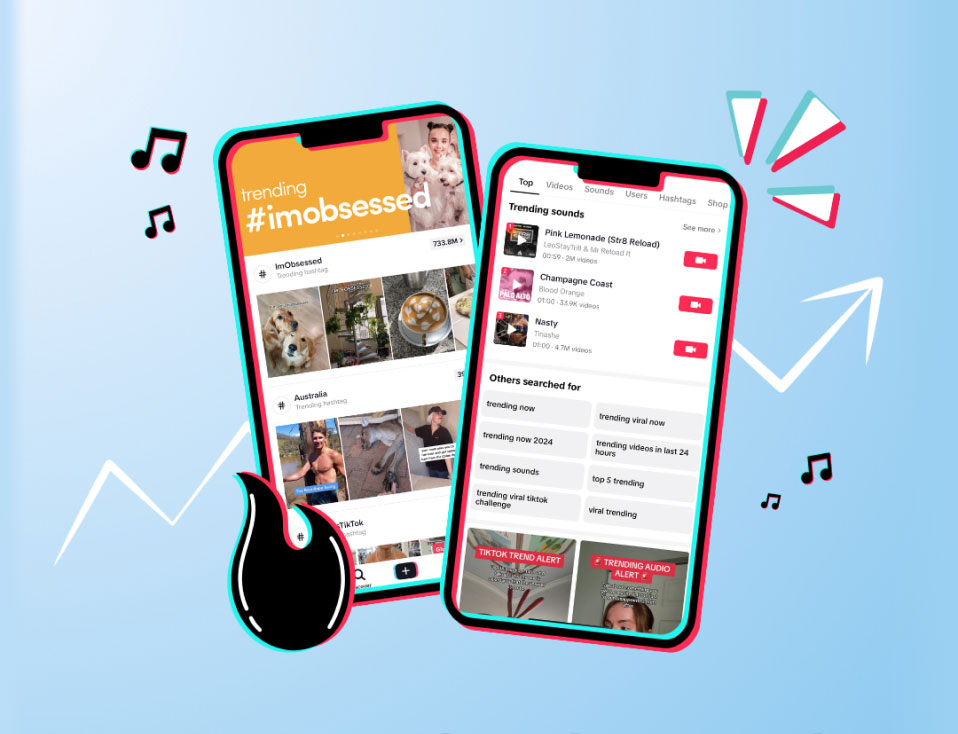Imagine a successful sports team like the All Blacks doing ZERO competition analysis before playing a game against the Wallabies.
Instead of watching old game footage, analyzing their in-game strategies, and assessing each player’s strengths and weaknesses, the team decided to… wing it.
That’s a recipe for disaster, amirite?
Whether you want to succeed in business or sport, you need to understand your opponents and how to use their strengths and weaknesses to your advantage.
That’s exactly what competitor research helps you do. It gives you the data to map out your game plan and predictably score a try against your rivals again and again.
Not sure where to start? Let’s help you conduct competitor research like a pro and learn how to leverage these insights to supercharge your success on social media.
What Is Competitor Analysis?
A competitor analysis involves snooping on your competitors to understand their strengths, weaknesses, products, and marketing strategies.
Usually, it involves a defined scope (such as reviewing your competitor’s website or social media channels). Plus, this analysis works best when you select a handful of direct competitors who operate in the same industry or niche as your brand.
Why Is a Competitor Analysis Important for Your Business?
When done correctly, a competitive analysis can give you data to back your business decisions and give your customers the best solution to the problem you solve.
By conducting a competitor analysis, you’ll be able to:
• Define or update your unique selling point (USP) and unique value proposition (UVP).
• Find gaps in the market landscape that you can tap into.
• Capitalize on your competitors’ weaknesses by improving your product or service.
• Identify success strategies and strengthen your marketing campaigns.
• Understand what is and what isn’t working in your industry.
How Often Should I Conduct a Competitor Analysis?
It depends on your industry. If you’re in a fast-paced vertical experiencing rapid change like tech or travel, conducting competitor analysis every quarter makes sense. If your business is in a more stable market, a biannual analysis will help you stay competitive and agile.
You should also conduct a competitive analysis during major business moments, such as launching a new product, entering a new market, or responding to industry developments. By monitoring pricing strategies, marketing campaigns, product innovations, and customer sentiment, you can create a business strategy based on data, not your gut.
How Does Competitor Analysis Help Improve My Social Media Strategy?
Competitor analysis helps improve your social media strategy by highlighting what is working and what isn’t within your niche. When you take a deep dive into your competitors’ social media content, you can identify trends, audience preferences, and successful tactics.
In short, it takes the “mystery” out of the equation and helps you hone your strategy faster.
That’s not all.
You might uncover unique gaps in the market to differentiate your brand. For example, if your competitors focus heavily on product promotions, you could stand out by sharing behind-the-scenes content.
Lastly, it gives you a benchmark. Observing key metrics like follower growth, engagement rates, or campaign success gives you realistic goals based on real data, not guesstimating.
How to Conduct a Competitor Analysis
Now, to the bit you’re most interested in: how do you conduct a competitive analysis? Here’s a step-by-step guide to everything you need to know!
Step 1: Identify Your Competitors
Grab your notebooks and pens, or open a new Google Sheets doc and brain-dump your competitors.
You’re looking for a mix of direct and indirect competitors who either offer the same solution, serve the same customer, or solve the same problem with a different product or service.
Start with the companies that immediately come to mind, and then turn to Google and social media to complete your list. If you already have an audience, ask your customers what other alternatives come up on their radar.
Here are some questions to help kick-start your competitor research:
• Who is targeting the same customers?
• Who are the leaders in your niche?
• Who is selling the same thing?
• Who is targeting the same keywords?
• Who is bidding on the same keywords?
Step 2: Take a Deep Dive into Their Business Model
Now that you have a list of companies to stalk, it’s time to whip out your darkest clothes and go full stealth mode.
During this stage, you want to learn as much about each competitor as possible.
You’ll start with a basic company overview. Visit the company’s website, LinkedIn, Crunchbase, or Glassdoor to learn about its history, founders, and employees.
Next, answer the following questions:
• Who is their target audience?
• What products or services do they sell?
• How is their product/services suite set up?
• How much market share do they control?
Step 3: Identify Your Competitor’s Strategies
Ready to get a deeper understanding of your competitor’s marketing strategies?
It’s time to break out the marketing mix, aka the 4 P’s: product, price, promotion, and place.
For the next part of your competitor research, answer the following questions for each company on your list.
Product
• What are they selling?
• What are the features and benefits of their product or service?
• What are the strengths? What are people raving about?
• What are the weak points? What are people complaining about?
Plann Tip: Use review sites and social media comment sections to help answer these questions.
Price
• What pricing model do they use? (Monthly subscription, annual plans, once-off purchase, etc.)
• What is the price for each product or service?
• What pricing strategies do they use? (Sales, discounts, buy-one-get-one-free, upselling, etc.)
• Do they use referral schemes, free trials, free shipping, or other perks?
Promotion
• What publications, podcasts, and other media outlets have mentioned your competitor?
• What is their content marketing strategy? Do they have a blog, YouTube channel, podcast, etc.?
• If yes, how well do their site and content organically rank in search?
• How do they promote their business? (Look for channels such as social media, email marketing, paid ads, print ads, influencer marketing, etc.)
• Does your competitor use a guest posting strategy? If yes, which websites have accepted their posts?
• What is their USP?
• What features and benefits do they emphasize?
Place
• Does your competitor sell online, in brick-and-mortar locations, or a mix of both?
• Do they sell directly or indirectly via partners or third-party marketplaces?
• How is the product or service delivered to the customer?
Step 4: Take Action

After your research, use Plann to take action on your new marketing strategy.
Congrats! You’ve made it through the most time-consuming part of competitor research.
Now, it’s time to turn your SWOT analysis observations into actionable insights for your business.
Here is the final set of questions to ask yourself as you analyze your data for each competitor:
• What are my competitor’s strengths?
• What are their weak spots? Where do I have the advantage?
• What are my weak spots? Where do they have the advantage?
• What opportunities in the market landscape have I discovered? What opportunities have they discovered?
• Which of my competitor’s strategies is working the best? Is it worth adopting those strategies?
• Which strategies are not working for them? Am I doing that?
• In what ways is this competitor a threat to my business?
Once you finish answering these questions, you’ll have a solid idea of each competitor’s strengths and weaknesses, revealing how you can improve your market share in the competitive landscape.
Tips for Tracking Competitors Regularly

Use your analysis to track your market position and improve your growth strategy.
Keeping tabs on your competition doesn’t have to feel overwhelming. With a smart system in place, like setting clear schedules, identifying key benchmarks, and using the right tools, you can easily stay in the loop and uncover opportunities to outshine your competitors.
Set a Review Schedule That Works for You
Tracking competitors doesn’t have to take up all your time. You just need a routine. Set up a quarterly schedule for fast-paced industries like technology, fashion, or travel to review their campaigns, content, and pricing strategies. For slower-moving markets, a biannual review should keep you up to date with your competitors.
Schedule reminders and store all your findings in a project management tool like Asana. Use the competitor research template to nip the initial setup in the bud.
Focus on the Right Metrics
You need to zero in on the metrics that matter most to get the most out of your tracking. Start with:
- Social Media Metrics: Use tools like Plann to track your engagement rates, follower growth, and the type of posts that drive high interactions and compare your results with competitors.
- Pricing and Offers: Visit competitors’ websites regularly to review their pricing structures, promotional offers, and bundles. Tools like Prisync can automate price tracking.
- Content Strategy: Analyse blog posts, videos, and downloadable content using BuzzSumo to find their most shared pieces. For example, if a competitor’s guide to travel planning is trending, consider creating something even better.
Use Tools to Make It Easy
Here are some tools to help you streamline the process and give your brand a competitive advantage:
- SEMrush or Ahrefs: Perfect for analyzing their keywords, backlinks, and organic traffic. For example, if a competitor ranks high for “luxury safaris in Kenya,” you can adjust your SEO strategy to target similar or complementary keywords.
- Adbeat or SpyFu: These tools show competitor ad spend, campaign performance, and creatives, giving you insight into what’s driving their traffic.
- Google Alerts: Set alerts for competitor brand names to get notified about news, blog posts, or press coverage.
Want a simple way to track everything? Google Sheets or Excel is your best friend. Create a dedicated competitor analysis sheet with columns for:
- Social media growth (followers, engagement rates).
- Top-performing content (blog posts, videos, guides).
- New product launches or promotions.
- Pricing strategy
- Ad campaigns.
Keep it organized with colour-coded categories, and update it each time you analyze competitors.
Ready, Steady, Start Sleuthing!
Competitor research isn’t an easy or quick thing to do, but it plays a crucial part in your success. Without it, you might miss market trends and opportunities to one-up your rivals.
But remember, it’s not about copying and pasting what your competitor is doing. Your analysis is to help you understand your target audience, how you can better serve your customers, and find tactics to help your business stand out.
Once your market research is done, it’s time to show up consistently on social media. With Plann, your all-in-one social media suite, you can strategically plan, create, and schedule all of your social media content ahead of time.
Ready to blow your competitors out of the water? Sign up for a 7-day free trial of Plann Pro!









